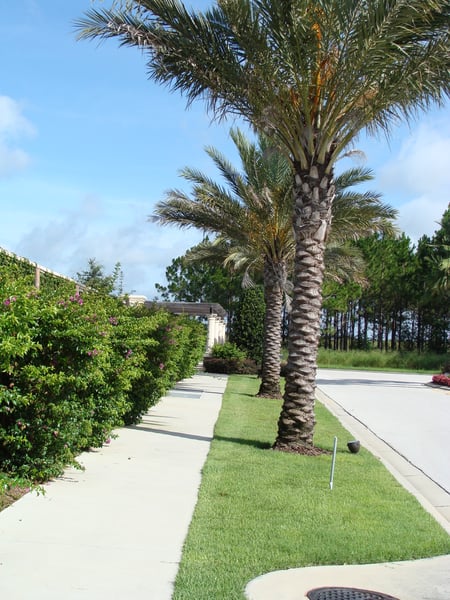
Home / Here on Earth / Everything You Should Know About Pruning Palms
If you have palm trees, you may be thinking about the appropriate way to prune them. Some palm trees don't require pruning, such as the royal or foxtail palm which automatically sheds its dead leaves. If you have palms that are not self-cleaning, you may need to prune them periodically.
Basics of Pruning Palms
When pruning palms, use a pole saw to eliminate any brown fronds. Keep the green fronds as they are. Care must be taken not to cut or otherwise harm the terminal bud or the entire tree will die.
Old leaves that persist on palms like the Washington palm can be removed, as they usually harbor rodents and insects and may cause a fire hazard.
When palms with heavy, large fronds like the Royal palm shed their bulky leaves, they can harm people and damage property. If they are developing in an area where falling leaves may be dangerous, get rid of leaves before they drop.
Hurricane Pruning
When pruning palm trees, less is generally better. You must never over-prune your palms by doing what's called "hurricane cutting”, or "hurricane pruning" where all but some fronds are pruned.
Palms are easily able to bear the high winds that hurricanes carry, so eliminating fronds isn't required. In fact, it can severely damage the palm tree.
When pruning palms, only eliminate fronds that are fully brown and that hang beneath the 3 o'clock or 9 o'clock position. When hiring a professional, make it clear what you expect from them by putting them in writing. Explain to them that you do not want the palms to have a mohawk, but a rounded canopy.
Always remember that the goal of pruning is to eliminate only dead growth.
Palm Tree Fruit Removal
With periodic pruning, you may want to eliminate the fruit stalks from some palm trees to prevent future problems and keep them safe. The big fruits of coconut palms can be hazardous to automobiles and pedestrians passing below the palm. You can avoid the development of fruits by eliminating the flower stalks. You can leave flower stalks on palms such as Christmas palms and others to take benefit of the ornamental characteristics of the fruit.
Queen palms fruit in large quantities and can create a mess when the fruits fall on driveways or sidewalks. The seeds may germinate if left alone and create weed issues. Coconut palms produce bulky fruits that can pose a danger to vehicles or people under them.
In these cases, you can eliminate the fruits or even the flowering stalks as and when required. It won't damage the tree and will prevent future problems. Never eliminate any green leaves, as doing so can harm the tree. If you are unable to do the job yourself, hire a certified arborist.
Effects of Pruning Palms.jpg?width=450&height=600&name=Jobsites%20029%20(1).jpg)
Pruning, or more essentially, extra pruning, can impact palms in many ways. If palms are over-pruned, the decreased canopy size leads to reduced photosynthetic capacity. Some studies have shown that in the short term, over-pruning can lead to higher leaf production rates, but the produced leaves were smaller in size compared to the ones on unpruned palms. If this practice is repeated often, the palm may also grow a smaller trunk diameter.
Some diseases, like the fusarium wilt of Canary Island date palm, are able to spread by pruning with infected tools. If you then use an infected tool to prune healthy leaves on a palm, the fungus will be transported in the process. When pruning palms, you must soak the tools in a disinfectant solution for five minutes before using them on the next palm. It is better to cut down the infected palm immediately after the disease is noticed to decrease the probability of spreading it to other palms. It is also a good reason not to cut living older leaves to obtain the so-called "pineapple" outcome on Canary Island date palms. Freshly pruned living leaf bases transmit chemicals that bring palm weevils, an acute insect pest of this palm.
Eliminating old palm leaf skirts like those found on Mexican fan palms can help get rid of hiding places for snakes, rats, scorpions, and other helpful or not-so-helpful wildlife. In Florida, Mexican fan palms nearly 30 feet tall or less generally retain their leaf bases or dead leaves, but in a year or so of growing this size, all of these old leaves will start to drop off by themselves. Afterward, these palms become mainly self-cleaning and don't require to be pruned manually.
When to Prune Palms
Palm pruning is done mainly for aesthetic purposes. For the palms, there is no specific time of the year that is better than another. Pruning dead foliage before hurricane season may decrease the probability that these freely detached leaves will become destructive in a storm.
Preferably, it is best to prune a dead leaf whenever it is seen on a palm, but that just isn't possible unless the palm is situated in your landscape and is sufficiently small to be simply accessible with regular pruning tools. Commercially, palms are pruned on a specific schedule (e.g., semi-annually, yearly, etc.) or whenever the palm's look becomes unpleasant to the owner.
Contact Down To Earth today to hire our experts to maintain your landscape in its best condition. We provide landscape maintenance and enhancement services throughout the year.
